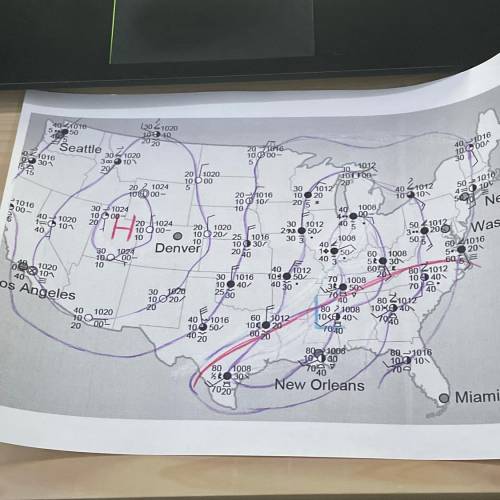Step 5: Locate fronts and forecast weather patterns.
a) Use Map D in the Data section.
b) Lab...

Biology, 14.04.2021 07:50 rhiannpelham60
Step 5: Locate fronts and forecast weather patterns.
a) Use Map D in the Data section.
b) Label the high pressure area with an H.
c) Label the low pressure area with an L.
d) Recall that fronts occur where there are large changes in temperature, air pressure, and
wind speed. Remember that the more fletches, or lines, on a weather symbol indicate higher
wind speeds. Using a blue colored pencil, draw and label the cold front on the map.
e) Using a red colored pencil, draw and label the warm front on the map.
f) Use the map to answer the follow-up questions.


Answers: 2


Other questions on the subject: Biology

Biology, 22.06.2019 07:20, boo8181
Agroup of plant cells was exposed to radiation, which damaged the chloroplasts and caused them to lose function. if the mitochondria were unharmed, what would happen to the overall function of the plant cells? a. the cells would not be able to make food, but would be able to release energy from biomolecules. b. the cells would not be able to replicate dna, but would be able to break down waste. c. the cells would not be able to break down waste, but would be able to replicate dna. d. the cells would not be able to release energy from biomolecules, but would be able to make food.
Answers: 1

Biology, 22.06.2019 09:30, ceeejay0621
Juan and carol were studying invertebrates in biology. they knew that segmented or earth worms preferred a dark, moist habitat. during this lab, they would be investigating the responses of organisms called planaria or dugesia tigrina. these were simple flatworms that still had a one-way digestive system and a very simple nervous system. juan and carol placed the planaria in a petri dish containing cool, distilled water that was partially covered with black paper. they shined a light on the dish. next, they removed the paper and placed a small amount of chicken liver at one end of the dish. they added a few large salt crystals to the water. finally, they added drops of hot water to the cool water in the petri dish. their results can be seen in the data table. according to their experiment, all but one conclusion is valid.
Answers: 1

Biology, 22.06.2019 10:30, DakotaOliver
Grasses--> mice--> cats--> coyotes suppose 10,000 units of energy are available at the level of the grasses. what is the total number of energy units lost by the time energy reaches the coyote?
Answers: 2

Biology, 22.06.2019 17:30, keke6361
Sally, age 3 months, has a moist, red, vesicular rash on her cheeks, the backs of her hands, and her arms. her mother said sally was constantly trying to scratch the rash and often has difficulty sleeping. her father has a family history of allergic rhinitis and asthma. discussion questions. 1. review atrophic dermatitis from chapter 3 and discuss the pathophysiology of sally’s symptoms. 2. why is the father’s medical history significant, and what can sally expect as she grows up? 3. discuss the need to limit scratching, and describe practical methods to achieve this.
Answers: 3
You know the right answer?
Questions in other subjects:

Mathematics, 13.01.2021 03:10



Mathematics, 13.01.2021 03:10

Mathematics, 13.01.2021 03:10


History, 13.01.2021 03:10



Mathematics, 13.01.2021 03:10



